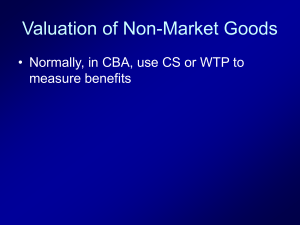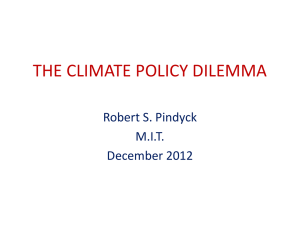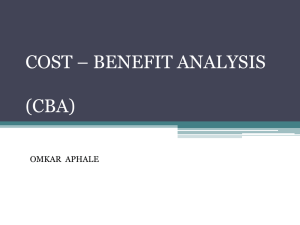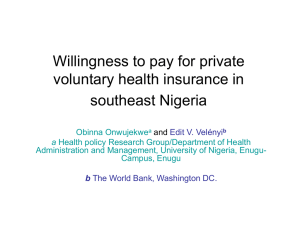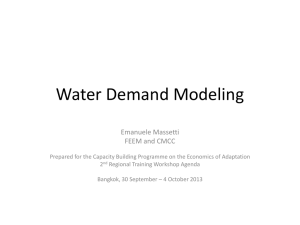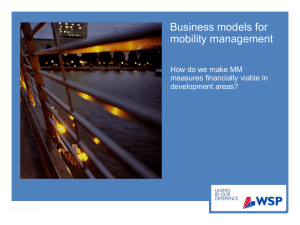Session 7
advertisement
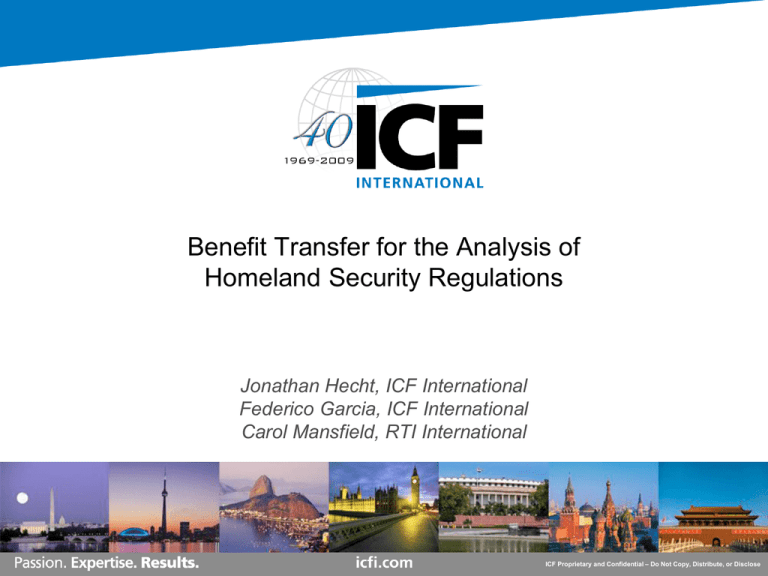
Benefit Transfer for the Analysis of Homeland Security Regulations Jonathan Hecht, ICF International Federico Garcia, ICF International Carol Mansfield, RTI International ICF Proprietary and Confidential – Do Not Copy, Distribute, or Disclose Background – U.S. Coast Guard (USCG) Willingness to Pay Project Note: This analysis does not represent the official view of the USCG. “Analysis of Willingness to Pay (WTP) for Marine Transportation Safety and Security.” • Ongoing contract to support USCG’s efforts to better articulate the benefits of its safety and security regulations. Reviewed literature on WTP for transportation safety and security. • • Compiled database of 39 WTP studies. Database contains summary, info. on explanatory variables, goodness of fit, validity tests, and measures of quality of the studies. Evaluated studies for use as source data for benefit transfer. ICF Proprietary and Confidential – Do Not Copy, Distribute, or Disclose 2 Methods – Selection of Methods and Data Mapping Use of benefit function transfer and preference calibration methods. • Literature review yielded studies of safety and security for transportation modes other than maritime. – Benefit value transfer approach not possible. Mapping of database studies to USCG program areas: • • • • Studies on nuclear safety, port security, or transportation of dangerous goods “Freight transport – Hazardous.” Studies on mass transit by road, rail, or air, or studies dealing only with congestion “Passenger travel – Commuter.” Studies on road travel in personal vehicles “Passenger travel – Other.” Studies on marine-based recreation “Recreational boating.” ICF Proprietary and Confidential – Do Not Copy, Distribute, or Disclose 3 Methods – Selection of Source Data Focused on the “Passenger travel – Commuter” USCG program area. Evaluated the suitability of WTP estimates for benefit transfer. Only one study was deemed suitable for use in a benefit transfer for maritime transportation. • • Carlsson et al. (2004) estimated WTP for reductions in risk of traveling by air and by taxi for residents in Sweden. WTP for reducing air travel risks was higher than WTP for reducing taxi travel risks. ICF Proprietary and Confidential – Do Not Copy, Distribute, or Disclose 4 Methods – Benefit Function Transfer WTP function from Carlsson et al. study included socioeconomic variables (gender, age, income, educational level), and variables describing the scenarios used to estimate WTP. We used various data sources (U.S. Census, etc.) to impute values for socioeconomic variables for the U.S. population into Carlsson et al.’s WTP function. We used the WTP function to calculate new WTP values, converted them to U.S. dollars, and inflated them from 2002$ to 2009$. ICF Proprietary and Confidential – Do Not Copy, Distribute, or Disclose 5 Methods – Preference Calibration We were able to implement this approach only for the air travel WTP estimates. – The income variable was not statistically significant for taxi travel model. We assumed a constant elasticity of substitution (CES) utility function. We solved the utility function for WTP for a change in passenger risk using values for the Swedish population, then substituted in values for the U.S. population. ICF Proprietary and Confidential – Do Not Copy, Distribute, or Disclose 6 Results – Transfer to U.S. Population Benefit function transfer results (in 2009$): • Average WTP for reducing risk of air travel fatality by 1 in 500,000: $63.26. • Average WTP for reducing risk of taxi travel fatality by 1 in 500,000: $6.43. Preference calibration results (in 2009$): • Average WTP for reducing risk of air travel fatality by 1 in 500,000: $67.73. • Greater sensitivity to changes in income than benefit function transfer results. ICF Proprietary and Confidential – Do Not Copy, Distribute, or Disclose 7 Results – Adaptation of Results to New Context and Risk Reduction Level Adaptation of Air and Taxi Results to a Maritime Context: • Used evidence from the literature to determine the similarities between maritime transportation and other travel modes. • Estimated a lower-bound, mean, and upper-bound WTP for reducing risks of maritime transportation to account for uncertainty. Adaptation of Results to a New Risk Reduction Level: • We scaled WTP proportionately with changes in the level of risk reduction. • Adapted the original results (risk reduction of 1 in 500,000) to a new risk reduction level of 1 in 100 million. ICF Proprietary and Confidential – Do Not Copy, Distribute, or Disclose 8 Results – WTP for Maritime Transportation Risk Reduction Results for general U.S. WTP Scenario WTP for Maritime Transportation Risk Reduction of 1 in 100 Million population. Results calibrated to Upper-bound $0.74 Mean $0.44 Lower-bound $0.13 WTP Scenario demographics of U.S. maritime passenger population. WTP for Maritime Transportation Risk Reduction of 1 in 100 Million Upper-bound $0.81 Mean $0.47 Lower-bound $0.12 ICF Proprietary and Confidential – Do Not Copy, Distribute, or Disclose 9 Concluding Remarks Benefit transfer is a viable option for estimating the benefits of safety and security policies. • A next step would be to test the method in the context of a cost-benefit analysis of a USCG regulation using the benefit transfer results. Benefit function transfer and preference calibration were preferred over the benefit value transfer method. Limitations include: (1) Lack of source data for a maritime context; (2) Lack of U.S.-based data; and (3) Lack of information on the relevant change in risk for USCG regulations. Other WTP studies provide useful context and additional information. • Smith et al. (2009) – Non-use benefits of transportation security. • Viscusi (2009) – Relative values of risks from different sources. • Jones-Lee and Loomes (1995) – Evidence of heterogeneity in WTP for risk reduction across transportation modes. ICF Proprietary and Confidential – Do Not Copy, Distribute, or Disclose 10


